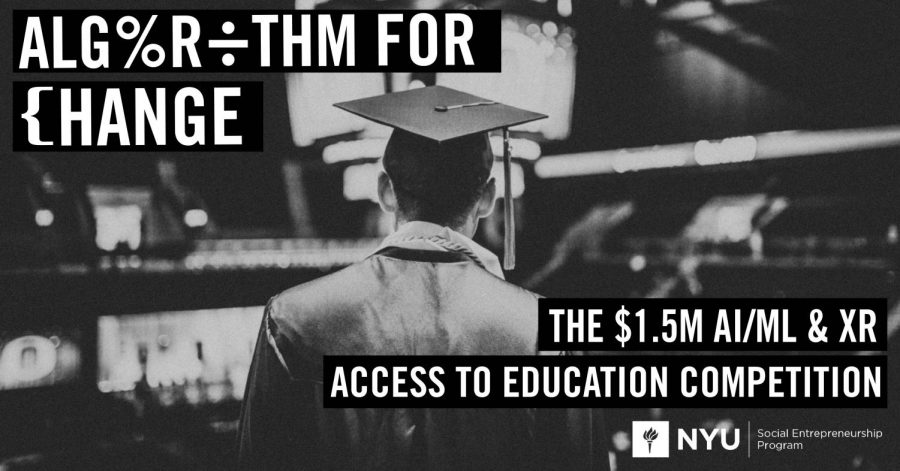Algorithm for Change: Inspiring Innovation in Education
Algorithm for Change is a $1.5 million dollar competition designed to encourage innovative thinking and application of artificial intelligence, machine learning and augmented reality. It seeks to address challenges in U.S. post-secondary education with a particular focus on low income, underrepresented and first-generation students.
March 19, 2018
What can technology do for education? More specifically, how can it help minorities and low-income students overcome barriers and achieve their goals? These are questions posed by Algorithm for Change, a new national competition organized by the NYU Social Entrepreneurship Program that will start accepting applications this spring.
With support from the Bill & Melinda Gates Foundation, the project has the funding to distribute a total of 1.5 million dollars to people with ideas on how to generate more success among low income, underrepresented minorities and first generation students, otherwise known as LIMFG students, through the technology of Machine Learning, Artificial Intelligence and Augmented Reality, abbreviated as ML, AI and xR. Algorithm for Change’s main goal is to encourage inventors and entrepreneurs to use these new, complex technologies to help LIMFG students get into and through college.
The competition is an incentive for people, including current students, to start making a change in society. Only 37 percent of Latinos and 35 percent of African-Americans enrolled at post-secondary institutions in 2015, which contrasts the 42 percent of whites and 63 percent of Asian-Americans, according to data from the United States Department of Education. Algorithm for Change seeks to fix this disparity.
For Gabriel Brodbar, executive director of the NYU Social Entrepreneurship Program, the winning ideas may come in many different forms.
“Whatever the effort is, the end beneficiary has to be low income minority students, whether it engages students at a high school level to help them get into college or is something that uses data to figure out why LIMFG students drop out,” Brodbar said.
In an email to WSN, Travis Reindl, senior communications officer for the Gates Foundation, emphasized the endless possibilities of technology in the social sphere.
“There are many ways that the power of technology can be used to aid today’s students,” Reindl said. “Everything from developing courseware to improve teaching and learning to advising systems that help students plot a course to their goals.”
While AI and ML show great promise, neither are being used to their full potential in the education sector, according to the Algorithm for Change website.
Brodbar believes that there are two reasons why this is happening: first, access to data is difficult, making it hard to develop a product that can be taken to scale. And second, there is simply a lack of communication.
“You tend to have, on the one side, great engineers with great technical skills, and on the other side, community members, living with challenges that engineers might have trouble understanding,” Brodbar said. “These two groups do not often connect, and we hope to help change that.”
The competition will reward three or more individuals and groups who aim to bridge this gap between engineers and struggling communities. Both NYU and non-NYU groups and companies are encouraged to apply. There are three tiers in which teams can apply: ideation, for those who have an idea and are getting started; validation, for those with a prototype ready and working, and commercialization for established companies who are already out there. The winner of each tier will be prized with $100,000, $300,000 and $700,000 accordingly.
NYU will lead the AI and ML side of the competition, while the xR challenge will be organized in a separate event by the startup accelerator Techstars.
Applications for the competition are due April 10, and the winners will be announced on July 12. The winners will use their rewards to continue leading change in LIMFG student lives through the use of technology.
“It is extremely important to remember that technology is simply a tool,” Reindl said. “It is people that make the difference when it comes to educational opportunity.”
A version of this article appeared in the Monday, March 19 print edition. Email Carol Oliveira at [email protected].


























































































































































